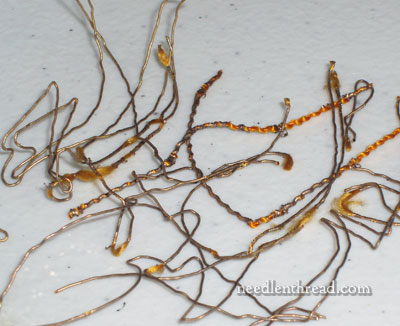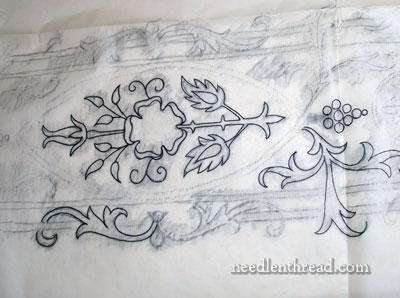After examining the 19th century embroidered panel up close, my next step: preserving the design. Before I could make a good tracing of the design, I had to remove some of the loose metal threads.

There really weren’t that many metal threads that had to be removed from the embroidery. I removed just the ones that were completely displaced, broken, or bent completely out of shape. I was able to gently replace some metal threads by pushing them back into the shape of the outline they were supposed to be creating. For the most part, though, at the lightest touch of these threads – and especially any extreme movement into another position – they came right off without any coaxing.

Then, it was time to make a rubbing. With the panel lying flat on a long table, I placed tracing paper over the whole panel. I use a canary-colored, very thin tracing paper that comes on a roll. You can find it at art supply stores and the like, and it’s also sold in some quilt stores as a “trace and sew” paper.
To make the rubbing, I used the side of a soft, dull charcoal pencil and proceeded carefully, to avoid the paper tearing or the charcoal piercing through it. The rubbing is not crystal clear, but it does give a general layout of the pattern. The goldwork outlines were especially handy for getting a good line – if not a solid line, at least they created a little line of charcoal blips that could be easily traced into a smooth line.
After rubbing, I removed the tissue paper from the embroidery and went over major lines with the pencil again, to darken them up.

Then, with the embroidery far away from my permanent pens, I touched out the major lines with permanent ink, so that they are easy to see. Next step is to clean all of the lines up and work up a layout that is accurate, and finally, I’ll trace it all into one clean, accurate pattern for future use.
Once I’ve finished the pattern completely, I’ll wrap the embroidery in tissue and lay it on a flat shelf, where I have several other old pieces of embroidery of this type. Once I have the time to devote to it, I’ll make a few minor repairs that will stabilize the piece, and then consider how to preserve and perhaps display it.
As for preserving and displaying, what are you thoughts? What would you do with this piece, if you liked it a lot and wanted to do something other than store it? Any thoughts or ideas? Feel free to share them below!
So that’s my adventure so far with this beautiful piece of embroidery!
Tomorrow, a little deviation from the norm: a sweet little hand embroidery pattern for you. See you then!







Wow, that is indeed a lovely piece! How about displaying it as it would have been? Sewing it to a plain chasuble and drape it over a plastic mannequin. It would ofcourse become a bit bulky to display :). Thanks for sharing!
Have a nice day, Jessica
A public Botanical Rose Garden which has a museum or gallery to display the work. Too beautiful not to be seen,especially afterr your labour of love.
If you’re going to replace some of the gold, it will be new and shiny while the older gold is dull. How do you deal with that? And I’m anxious to see how you handle the silk that has come apart.
It’s a lovely piece of needlework, and must have been stunning in candlelight when new.
I’d “quilt” it to a backing fabric and frame it behind glass. It would be nicer to have it without glass, but I’d be concerned about dust and keeping it clean. Not so much worried about myself dusting it, as someone else with good intentions vacuuming without a screen or just giving it a good whack or 2.
What a lovely gift!
I loved seeing the changes time and use have brought to the piece. And, while I understand the need to make it right, perhaps it would be better to make some repairs but preserve others in their current state?
As for display, I’d be tempted to mount it in a custom shadow box with museum quality, anti-reflective glass. If you could get a photo of it when it was part of the chasuble and mount that with the preserves/restored piece it would make a wonderful time capsule/snap shot.
Mary, I don’t know how big this piece is, but it would be fabulous incorporated into an “art” screen. I worked at a place where there was one composed of some exquisite woodwork and wonderful needlework. It was a busy public place and so many people commented they’d like to have one just like it.
Ann
When I was pregnant with my now 48 year old daughter I was given a glorious 5 inch wide woven, rose flowered, antique silk ribbon. Her middle name is Rosina and I used it to decorate her bassinette. Now almost half a century later it has deteriorated badly but I want to preserve it. A stitcher at the Royal School of Needlework taught me that I can gently layer it between fine netting to keep it intact enough to be beautiful for yet another generation or more. I am so pleased with that.
In order to display it, I would make a wood frame slightly larger than the piece itself. Make it of silk over linen, with maybe something else under it. Linen should be strong enough to hold the fabric, but it might be necessary to pad the wooden frame from the linen. Then carefully sew the embroidery piece to the frame. Since it had been cut from something larger, it would not hurt to turn under a small bit of the backing fabric, so there would be a double layer to sew through to put a little less strain on the original backing.
This is indeed a beautiful piece. It would be a shame to roll and store. I would definitely frame it and display. In my home for awhile and then possibly donate to our local vented for the arts.
For some items it is easier to simply photocopy the fabric then outline it and write notes. Factors to consider would be size, sensitivity to light, sensitivity to heat, and colour. If you scan the piece it could be even better in the long term.
I am really sorry if I have missed something, but I don’t quite understand a couple of the suggestions given, eg, replacing the gold threads that you have removed, and the one about photocopying and/or scanning.
I don’t recall your having said anything about replacing those gold threads, and I would be surprised if you did I (of course I am willing to be surprised), but I understand that it isn’t usual practice to conserve a piece by adding such obviously new elements. The general feeling in galleries is that an item is ‘conserved’ so as to maintain it’s current condition. Is the scanning option in place of or in addition to your charcoal rubbing?
I too think that it would be best displayed under glass for protection.
Hi, Christina –
No, you’re right, I’m not replacing any of the threads. I just removed the ones that were so out of place that they confused the design and made it look particularly messy.
I think the photocopy or scan of the piece is a good idea, and it would have been my first choice, if I didn’t have to drive 80 miles to find a place that could handle a one-off that size. I have a scanner, but it is very small and I don’t want to bend the piece and shut the top of the scanner on it while folded. The rural woes. I’ll probably take it will me the next time I go to town, though, and have a full sized color photocopy of it made and a few black and whites. I’ve done that before with old pieces.
Thanks for the comments, everyone!
MC
Hi Mary
This is not about how to display this piece, haven’t arrived at any thoughts on that yet. Just wondering if you will, during the restoration, replace any of the gold work. If you did it would outshine the rest, me thinks.
You are brave to attempt it, I think it would be wonderful framed horizontally, it would also make a great pattern for stained glass window.
Please keep showing us your progress along the way.
Keep well
Sandy Southern Highlands Australia.
Hello Mary,
Well, to your question. I would give this beautiful panel to a museum. There are a few which are specialized in embroidery. For example:
The Textile Museum, Washington, US
The Embroiderers Guild of America, Louisvile, US
The Victoria & Albert Museum, London, UK
Embroideres’ Guild Museum, Surrey, UK
I think they have experience in preserving and the piece can be watched by a lot of people and embroidery lovers. But it is of course up to you and I can underestand if you do not want to give it away. It’s so beautiful.
P.S. Your reports are always so interesting, entertaining and written with such a nice humor(this belongs to your extraordinary writing style) that your site is almost the only one I always do completey read.
Best regards from Munich
Cornelia
What would the advantages be of scanning over taking close-up photos and using software to combine them? Other than a scan would be 1 file. Is higher resolution possible with a scanner? Easier and less time than the multiple photo route? Just asking, as your closeups are always so nice, Mary.
Hi, Gail – a full scan or photocopy would give you the advantage of an accurate pattern, placement of techniques, fairly accurate color (if the photocopy can be done in color), and so forth, without having to trace out a pattern. It’s also a nice way to have a record of the whole piece, and not just parts. But the macro shots are great for really seeing things that are more difficult to see with the naked eye, because you can enlarge them and really get down to the nitty gritty detail! I like doing both when I can. But… to get a whole scan or photocopy of a piece this size is not so easy, as there’s nowhere close by that does it. Eventually, I’ll get it done, though! ~MC
I would encase it between two pieces glass to view from both sides, custom made frame from old wood and then hang it so it can be admired front and back for its beauty! Thank you for sharing with us Mary.